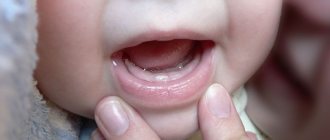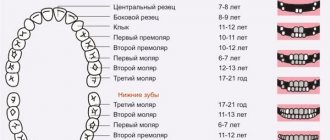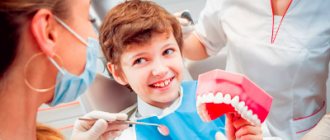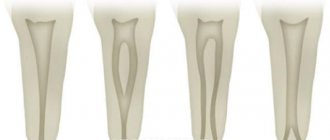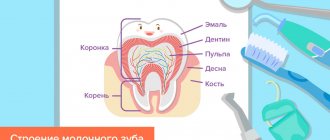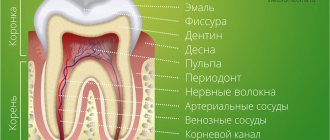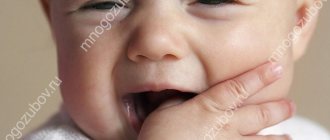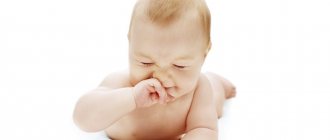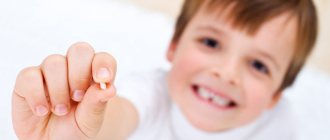Features of the period.
During this period, the formation and further development of the roots of baby teeth occurs: they are strengthened in the bone tissue of the jaws. The processes of root formation smoothly flow into the processes of their resorption and replacement with permanent teeth, the rudiments of which are located under the milk teeth.
The presence of interdental spaces between the incisors and canines of the upper and lower jaws is a sign of a “normal” correctly developing occlusion of primary teeth. The absence of interdental spaces in the primary dentition indirectly indicates a lack of space for the eruption of permanent incisors and canines, the crowns of which are significantly wider.
PHOTO: Teeth of a 3-year-old child. By the age of 3, a child already has a full set of teeth in his mouth. There should be spaces between baby teeth.
Starting from 5-6 years of age, the bite of temporary (baby) teeth is replaced with permanent ones. This is preceded by the growth of the rudiments of permanent teeth and the physiological resorption of the roots of milk teeth. As the roots of baby teeth are reabsorbed, mobility of these teeth appears. At this age, parents often note mobility of the lower and upper front teeth (deciduous incisors). When the root is completely absorbed, the tooth may fall out on its own: sometimes children “help” the tooth fall out with their tongue, constantly rocking it. Sometimes the “loss” of a resorbed tooth occurs while eating or playing.
Closer to 6 years, the first permanent chewing tooth (first molar) erupts behind the last milk tooth. The eruption of the first permanent molar is not accompanied by the loss of any tooth and does not cause any discomfort to the child, so it often goes unnoticed.
Parents often take the first permanent chewing tooth for additional milk, as it bursts behind all the milk teeth and this does not precede the loss of the milk tooth: it seems that the child has 24 malate tooth.
PHOTO: Milk teeth in children aged 6 years. The lower lateral incisors fell out. Soon permanent lateral incisors will appear in their place.
What is the danger of premature loss of baby teeth?
Trauma, caries and other dental diseases can cause the loss of a baby tooth. In place of the tooth there remains a “gap” in the dentition, which can cause significant disturbances in the formation of a permanent bite:
- crowding or crowding of teeth;
- dystopia of the tooth, when it erupts outside the dentition;
- horizontal overjet or excessive overlap of the lower front teeth with the upper ones;
- overbite or changing the distance between the chewing surfaces of opposing teeth in the vertical plane.
At the initial stage, changes may be minor. However, over time they begin to progress rapidly.
If a baby tooth is lost prematurely, then it is advisable to “close” the defect in the dentition that has formed in its place with a removable denture. Most often, so-called immediate dentures are used, which in private conversations dentists may call “clothespins.”
It is not only the fact of tooth loss that matters, but also the reason why it happened. Preventing childhood injuries is a good thing, but not always 100% effective. But in terms of prevention and treatment, caries is much simpler. If you consult a doctor in a timely manner, initial changes in the enamel can be eliminated with the help of special gels and varnishes, and emerging carious cavities can be cleaned and filled without the use of a drill.
It is not recommended to leave caries unattended, as these are not just black spots on the teeth. This is primarily a breeding ground for pathogenic microorganisms, an infection whose toxic effect on the body can lead to serious consequences. A reliable connection between caries and pathology of the kidneys and digestive system has been established. Changing teeth cannot solve the problem of caries in a child. Milk and permanent teeth “neighbor” each other for a long time, which increases the likelihood of damage to permanent teeth by the carious process.
Typical problems.
The most typical problem between the ages of 3 and 6 years is the development of caries of primary teeth in the area of the first and second primary molars. The narrow interdental spaces between the first and second primary molars, which are difficult for a child to reach, are an ideal place for plaque to accumulate. As a result, caries forms on the surface of the teeth hidden from the eyes of parents (between the 4th and 5th milk teeth). Being unnoticed, the carious process quickly progresses, complicated by inflammation of the nerve of the tooth (pulpitis).
With poor oral hygiene and a large number of carious teeth, caries of the permanent molar (6th tooth) often develops, high-quality treatment of which is only possible by a pediatric dentist.
What complications may arise?
Baby teeth did not fall out on time. The cause of the problem must be determined by the dentist. This usually requires an x-ray. In the image, the specialist can see the degree of development of the molars.
The appearance of caries and the occurrence of pulpitis. In this case, there is a change in body temperature, the appearance of severe pain and a general deterioration in the child’s well-being.
A very common situation occurs when a molar tooth (one or more) has already begun to appear, but the milk tooth does not fall out. As a result, the new tooth will look for other ways to grow, which will lead to a change in its direction and displacement. The result is a violation of the bite and the even position of the dentition. To eliminate the problem, you will need to consult an orthodontist.
The use of anesthesia in children for dental treatment
Local anesthesia
As a rule, dental treatment in children takes place under local anesthesia - application (without an injection) and infiltration (with an injection). The first provides superficial anesthesia, but it cannot be called completely harmless - a child can swallow a solution containing a high concentration of lidocaine. The injection is more reliable because it completely blocks pain.
Anesthesia
Dental treatment for children is associated with certain problems: one child is restless and hyperactive, another is afraid of the doctor and refuses to open his mouth. But teeth need to be treated, so in some cases general anesthesia remains the only option. In Western countries, this method has been used for a long time to treat diseased teeth in children over 1 year old. There is an opinion that anesthesia can affect memory and interfere with the normal development of speech. This is theoretically possible, but in practice this is an exceptional case. The cause of complications is not anesthesia, but the stress that the child received. Chronic disease may also manifest itself in combination with general anesthesia. However, without it it is impossible to cure multiple bottle caries in one go. The child simply cannot withstand 2 hours of necessary manipulations and filling of all teeth.
Before using general anesthesia, a number of studies are required:
- general blood analysis;
- biochemical studies;
- blood sugar level;
- electrocardiography.
Before the operation, you should not eat for 6 hours; 4 hours before the introduction of anesthesia you will have to stop taking any liquid, including water. The child is gently put to sleep with a gaseous sedative based on sevoflurane. He will wake up immediately after increasing the dose of oxygen. All reflexes return to normal within 15 minutes.
Contraindications to general anesthesia
Even a minor cold is a contraindication for anesthesia. After any illness, at least 2 weeks must pass. No vaccinations should be carried out 2 weeks before anesthesia and 2 weeks after it.
How many teeth should a child have per year?
During this period, baby teeth begin to cut.
They begin to break out in the following sequence on the upper and lower jaws. On the top:
- 8-12 months. Central incisors.
- 9-13 months. Lateral incisors.
- 16-22 months. Fangs.
- 13-19 months. First molars.
- 25-33 months. Second molars.
In the lower jaw, this process is distributed in time somewhat differently:
- 6-10 months. Central incisors.
- 10-16 months. Lateral incisors.
- 17-23 months. Fangs.
- 14-18 months. First molars.
- 23-31 months. Second molars.
It is worth noting that these time limits are averaged and deviations up or down by 1-3 months are considered normal.
If you want to know how many teeth a child has per year is considered normal, you should refer to the chart described above. You get that at the age of 12 months there should be 6-8 of them.
How to make teething easier
As already mentioned, a special cooling gel and, of course, the main assistant for parents - a teether, can help the baby with teething. There are currently many of the latter, and by the time teeth appear, it is highly advisable to stock up on not one, but several such toys.
The child will most likely choose the teether that he likes.
- Silicone massagers are softer. If you cool them in the refrigerator before using, you can achieve a cooling effect.
- Rubber massagers are stiffer, stimulate the gums better and, as a rule, have less relief.
A child with different teeth may prefer different types of teethers. For example, my son actively used silicone with his upper incisors, and regular rubber with his fangs.
Traditional methods to facilitate the teething process
In addition to special devices that are sold in pharmacies, you can help your baby with “folk” remedies:
- Give a crust of bread to chew if your baby is already eating solid food. The son was gnawing on his favorite treat - children's cookies. The pleasant taste and slight stimulation of the gums helped relieve his condition for a while.
- If the process is very painful for the baby, and the teether seems unattractive to him, you can let him suck your finger and give him a light massage.
- You can wipe your gums with a chamomile solution - it will relieve inflammation and promote the healing of small wounds. I brewed chamomile and left it in the refrigerator for a few minutes, then wiped my son’s gums with a gauze swab dipped in the cool infusion.
- Decoctions of burdock, sage and plantain roots relieve inflammation, which can also be used to lubricate the gums during a massage.
- Honey will help relieve irritation if the baby is not allergic to bee products. You can wipe your gums, or let them suck on a piece of gauze wrapped around your finger and previously soaked in diluted honey.
- You can brew soothing tea with lemon balm, mint, and valerian. The main thing is that the baby is not allergic to such herbs, and their concentration is small. Mothers can also drink this tea if the baby is breastfed and does not refuse the breast. This measure will make the baby calmer and make it easier to fall asleep.
Don't forget about the beneficial effects of cold. If your baby already eats fruits and vegetables, you can chill the pieces in the refrigerator and give them to your baby.
And remember that the main thing for a child during the teething period is the affection and care of the mother. Feeling your support and love, the baby will be less capricious and will go through this stage of growing up more easily.
Molars grow crooked
Molars are also subject to crooked growth. They can begin to actively grow before the temporary ones become loose and fall out. Encountering this natural obstacle in the process of their growth, they can grow crookedly than would be intended by nature - they are “led” to the side. If the growth of a molar is detected immediately after a temporary one, this defect leads to a curvature of the bite, which is why the child or teenager will need the help of an orthodontist. In this case, it is necessary to urgently remove the temporary tooth that is interfering with the growth of the permanent one. If time has not yet been lost, it may be possible in this way to remove the predisposition of the same tooth to acquired curvature. Despite the fact that a teenager, having realized the uselessness of a temporary tooth, can independently loosen it and remove it, doctors strongly advise refraining from such a step so that the child avoids, for example, sepsis.
Molars fall out
If molars suddenly begin to fall out suddenly, this is a sign that the child’s health is not in the best condition. Tooth loss is preceded by both systemic diseases (immune problems, impaired development of connective tissue) and local ones (caries, pulpitis, periodontal disease, etc.). Tooth from permanent dentition. When lost, it leaves behind a permanent problem. A radical solution could be a complete insertion of an artificial tooth - but... Before it is carried out, the child will have to use a removable and replaceable prosthesis before he grows up.
Teething symptoms
Teething, although a natural process, can cause significant inconvenience. Moreover, the problem, as a rule, does not arise with the first tooth. The lower incisors come out relatively painlessly, but the upper and molars can cause a lot of trouble.
The upper jaw is denser and it is more difficult for teeth to “pierce” it. Molars cause discomfort due to their size.
My son’s first teeth appeared spontaneously, and even the upper incisors erupted quite easily, but then the nightmare began. Almost simultaneously, four teeth began to appear, then two more were added to them, and we learned everything that we had only read about in books before. The child was capricious, refused to eat anything, and could not sleep at night. Only the gum gel saved me, and even then not for long, since it was used strictly according to the instructions in order to avoid complications.
What symptoms can you use to understand that your baby is suffering from teething problems?
- the child becomes capricious;
- in the mouth you can notice redness and, as it were, loosening of the gums at the site of tooth eruption;
- salivation increases;
- the baby may refuse solid food, his taste preferences may change, he may not eat at all;
- a slight increase in temperature may be observed - up to 37.7-38 ° C.
Along with redness at the site of tooth growth, in rare cases, a small hematoma or even an abscess may be observed. They pass with his appearance.
If the inflammation is significant, accompanied by a significant increase in temperature, and the baby’s condition worsens, it is better to take him to the dentist, who will treat the site where the tooth appears to prevent the development of infection.
No molars
The molars, despite the specific timing specified above, may ultimately not hatch. For example, temporary teeth do not fall out for a long time, and permanent teeth do not grow for a long time after they fall out. At the first stage, the dentist will take an X-ray of the condition of the child or teenager’s jaws. The X-ray machine will clearly project what should grow in place of the supposed teeth, which teeth are ready to hatch, and whether they exist at all. But the problem will immediately become obvious, and the reason for it most likely lies in the physiology of the child, which has undergone some delay. If this is true, be patient: in the end, the teeth will not take long to arrive. But if the picture shows emptiness, you are faced with a complete absence of teeth, the reason for which is a violation of the intrauterine development of the fetus during the mother’s pregnancy. Only prosthetics will help here - artificial insertion of false teeth.


